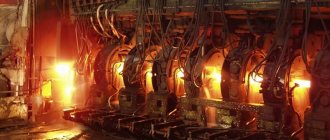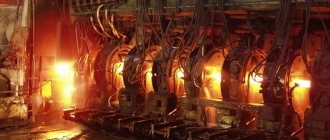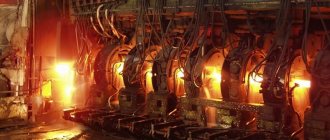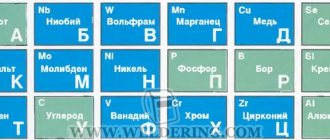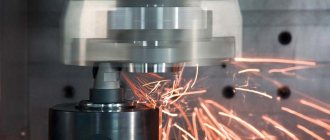4. TOOLING HIGH-SPEED STEEL
High-speed steels are characterized by increased red resistance (600–650 °C) and are the most common tool material. Approximately 70% of all metal-cutting tools are made from high-speed steels.
The grades, chemical composition and technical requirements for high-speed steels are regulated by GOST 19265–73. The chemical composition of the main grades of high-speed steels is given in table. I.3.
We will advise you on any questions!
Have a question?
Our services
Any specialist who deals with metal is familiar with the concept of “steel grade”. Deciphering the markings of steel alloys makes it possible to get an idea of their chemical composition and physical characteristics. Understanding this marking, despite its apparent complexity, is quite simple - it is only important to know on what principle it is compiled.
Rarely does production operate without steel, so understanding its grades is extremely important
The alloy is designated by letters and numbers, which can be used to accurately determine which chemical elements it contains and in what quantity. Knowing this, as well as how each of these elements can affect the finished alloy, it is possible to determine with a high degree of probability exactly what technical characteristics are characteristic of a particular grade of steel.
Chemical composition
Chemical composition, % (GOST 19281-2014)
| C, no more | Si | Mn | P | S | Cr | Ni | Cu | V | other elements |
| no more | |||||||||
| 0,12-0,18 | 0,40-0,70 | 0,40-0,70 | 0,030 | 0,035 | 0,60-0,90 | 0,30-0,60 | 0,20-0,40 | no more than 0.12 | — |
Types of steels and features of their markings
Steel is an alloy of iron and carbon, the content of which is no more than 2.14%. Carbon gives the alloy hardness, but if it is in excess, the metal becomes too brittle.
One of the most important parameters by which steels are divided into different classes is the chemical composition. Among the steels according to this criterion, alloyed and carbon steels are distinguished, the latter are divided into low-carbon (carbon up to 0.25%), medium-carbon (0.25–0.6%) and high-carbon (they contain more than 0.6% carbon).
Types of steels
By including alloying elements in the steel, it can be given the required characteristics. It is in this way that, by combining the type and quantitative content of additives, grades with improved mechanical properties, corrosion resistance, magnetic and electrical characteristics are obtained. Of course, it is possible to improve the characteristics of steels using heat treatment, but alloying additives make it possible to do this more efficiently.
Based on the quantitative composition of alloying elements, low-, medium- and high-alloy alloys are distinguished. In the first alloying elements there is no more than 2.5%, in medium alloyed elements - 2.5–10%, in highly alloyed ones - more than 10%.
Steels are classified according to their purpose. Thus, there are instrumental and structural types, grades distinguished by special physical properties. Tool types are used for the production of stamping, measuring, and cutting tools, structural ones - for the production of products used in construction and mechanical engineering. Alloys with special physical properties (also called precision) are used to make products that must have special characteristics (magnetic, strength, etc.).
Classification of steels by purpose
Steels are also contrasted with each other based on their special chemical properties. Alloys of this group include stainless, scale-resistant, heat-resistant, etc. Typically, stainless steels can be corrosion-resistant and stainless steel for food - these are different categories.
In addition to useful elements, steel also contains harmful impurities, the main ones of which are sulfur and phosphorus. It also contains gases in an unbound state (oxygen and nitrogen), which negatively affects its characteristics.
If we consider the main harmful impurities, phosphorus increases the brittleness of the alloy, which is especially pronounced at low temperatures (the so-called cold brittleness), and sulfur causes cracks in metal heated to high temperatures (red brittleness). Phosphorus, among other things, significantly reduces the ductility of heated metal. Based on the quantitative content of these two elements, steels are divided into ordinary quality (no more than 0.06–0.07% sulfur and phosphorus), high-quality (up to 0.035%), high-quality (up to 0.025%) and especially high-quality (sulfur - up to 0.015%, phosphorus - up to 0.02%).
The marking of steels also indicates to what extent oxygen has been removed from their composition. According to the level of deoxidation, steels are divided into:
- calm type, designated by the letter combination “SP”;
- semi-calm - “PS”;
- boiling - “KP”.
Processing steel 15HSND
Steel 15HSND is well processed in all ways; this is one of the main advantages of the material, ensuring its continued wide popularity throughout the world. Forging begins at a temperature of 1180C and ends at 840C. Cutting is carried out after normalization and tempering procedures, using machine tools, preferably plasma machines for maximum accuracy. Cold-rolled thin sheets are made from steel 15ХСНД; bending and cold stamping are allowed. The metal can be welded without restrictions; heat treatment is not required either before or after welding. Steel can be hardened at a temperature of 900C in water and then tempered.
What does the steel marking mean?
It has become quite easy to decipher the brand; you just need to have certain information. Structural steels of ordinary quality and not containing alloying elements are marked with the letter combination “St”. By the number following the letters in the name of the brand, you can determine how much carbon is in such an alloy (calculated in tenths of a percent). The numbers may be followed by the letters “KP”: from them it becomes clear that this alloy has not completely gone through the deoxidation process in the furnace, and accordingly, it belongs to the boiling category. If the brand name does not contain such letters, then the steel corresponds to the calm category.
Chemical composition of carbon structural steels of ordinary quality
Structural unalloyed steel, which belongs to the quality category, has two numbers in its designation; they are used to determine the average carbon content in it (calculated in hundredths of a percent).
Before we begin to consider the grades of those steels that include alloying additives, you should understand how these additives are designated. Marking of alloy steels may include the following letter designations:
List of alloying additives used
Delivery 15kp
Supplied in the form of long products, including shaped steel according to the regulations of GOST 2590-2006 Hot-rolled round steel , GOST 2591-2006 Hot-rolled square steel , GOST 1133-71 Forged round and square steel, GOST 19771-93 Equal-flange bent steel angles , GOST 8509-93 Hot rolled equal flange steel angles , GOST 8510-86 Hot rolled unequal flange steel angles , GOST 103-2006 long steel strip , GOST 503-81 Cold rolled low carbon steel strip, GOST 103-76 Hot rolled steel strip , GOST 8 2-70 Hot-rolled broadband universal steel, GOST 3282-74 General purpose low-carbon steel wire , GOST 17305-71 Carbon structural steel wire , GOST 3262-75 Steel water and gas pipes .
| Long and shaped rolled products | GOST 1133-71; GOST 8283-93; GOST 8282-83; GOST 8281-80; GOST 8278-83; GOST 2879-2006; GOST 2591-2006; GOST 2590-2006; GOST 19771-93; GOST 9234-74; GOST 10551-75; GOST 11474-76; |
| Sheets and strips | GOST 14918-80; GOST 103-2006; GOST 6765-75; GOST 16523-97; GOST 82-70; GOST 19903-74; GOST 19904-90; |
| Long and shaped rolled products | GOST 1050-88; GOST 8560-78; GOST 1051-73; GOST 8559-75; GOST 10702-78; GOST 7417-75; GOST 14955-77; |
| Sheets and strips | GOST 1577-93; GOST 4405-75; GOST 4041-71; |
| Ribbons | GOST 19851-74; GOST 1530-78; GOST 10234-77; |
| Steel pipes and connecting parts for them | GOST 10704-91; GOST 10705-80; GOST 10707-80; GOST 3262-75; |
| Classification, nomenclature and general norms | GOST 2771-81; |
| Low carbon steel wire | GOST 5663-79; GOST 792-67; GOST 1526-81; |
| Medium and high carbon steel wire | GOST 9850-72; GOST 17305-91; GOST 7372-79; GOST 26366-84; GOST 3920-70; |
Designation of steels with alloying elements
As mentioned above, the classification of steels with alloying elements includes several categories. The marking of alloy steels is compiled according to certain rules, knowledge of which allows one to quite simply determine the category of a particular alloy and the main area of its application. In the initial part of the names of such brands there are numbers (two or one) indicating the carbon content. Two numbers indicate its average content in the alloy in hundredths of a percent, and one – in tenths. There are also steels that do not have numbers at the beginning of the brand name. This means that the carbon content in these alloys is within 1%.
Example of alloy steel marking
The letters that can be seen behind the first digits of the brand name indicate what the alloy is made of. The letters that give information about a particular element in its composition may or may not be followed by numbers. If there is a number, then it determines (in whole percentages) the average content of the element indicated by the letter in the alloy, and if there is no number, it means that this element is contained in the range from 1 to 1.5%.
At the end of the marking of certain types of steel there may be the letter “A”. This suggests that this is high quality steel. These grades may include carbon steels and alloys with alloying additives in their composition. According to the classification, this category of steels includes those in which sulfur and phosphorus amount to no more than 0.03%.
Substitutes of domestic and foreign production
Steel 15HSND is popular on the market and has many analogues, both in Russia and abroad. If replacement is necessary, steel is selected that exactly or approximately matches the original in terms of performance characteristics. In Russia there are at least five brands suitable as a substitute for the 15HSND alloy. For detailed information on exact and approximate analogues, see the tables below.
| Rolled metal grade | Substitute |
| 15HSND | 14ХГС |
| 14SND | |
| 15GF | |
| 16G2AF | |
| 16GS |
Foreign analogues
| Europe (EN) | 1.0562, 1.0565, 1.0566, 1.1106 |
| Germany (DIN) | StE 355, WStE 355, TStE 355, EStE 355 |
| USA (ASTM) | A 633 Gr.C, A 588 |
| France (AFNOR) | E 355 R/FP |
| Sweden (SIS) | 2132 |
| Japan (JIS) | QLA 37 |
| Italy (UNI) | Fe E 355 KG, Fe E 355 KW, Fe E 355 KT |
| Spain (UNE) | A 355 KG; DD AE 355 KW, AE 355 KT |
Examples of marking steels of various types
Determining the grade of steel and assigning an alloy to a certain type is a task that should not cause any problems for a specialist. You don’t always have a table at hand that gives a breakdown of brand names, but the examples given below will help you figure it out.
Content of elements in common steel grades (click to enlarge)
Structural steels that do not contain alloying elements are designated by the letter combination “St”. The numbers following are the carbon content, calculated in hundredths of a percent. Low-alloy structural steels are marked somewhat differently. For example, 09G2S steel contains 0.09% carbon, and alloying additives (manganese, silicon, etc.) are contained within 2.5%. 10KhSND and 15KhSND, which are very similar in their markings, differ in different amounts of carbon, and the share of each alloying element in them is no more than 1%. That is why there are no numbers after the letters indicating each alloying element in such an alloy.
20Х, 30Х, 40Х, etc. – this is how structural alloy steels are marked; the predominant alloying element in them is chromium. The number at the beginning of such a mark is the carbon content in the alloy in question, calculated in hundredths of a percent. The letter designation of each alloying element can be followed by a number, which is used to determine its quantitative content in the alloy. If it is not there, then the specified element in the steel contains no more than 1.5%.
You can consider an example of the designation of chromium-silicon-manganese steel 30KhGSA. According to the labeling, it consists of carbon (0.3%), manganese, silicon, and chromium. It contains 0.8–1.1% of each of these elements.
Mechanical properties
| GOST | Delivery status | Section, mm | σ0.2, MPa | σв, MPa | δ5(δ4), % |
| no less | |||||
| GOST 19281-89 | Long and shaped rolled products | From 5 to 10 | 345 | 490 | 21 |
| From 10 to 32 incl. | 325 | 470 | 21 | ||
| Sheet and strip as delivered (transverse samples) | Up to 32 incl. | 345 | 490 | 21 | |
| GOST 17066-94 | Hot rolled sheet | From 2 to 3.9 incl. | — | 490 | (17) |
Mechanical properties during tensile testing (GOST 19281-2014)
| Strength class | Rolled cross-section dimensions, mm | steel grade | Mechanical properties, no less | ||
| Yield strength σt, N/mm2, | Tensile strength σв, N/mm2, | Relative elongation δ5, % | |||
| 325 | Up to 60.0 incl. St. 60.0 to 140.0 | 15HSND | 325 | 450 | 21 |
| 345 | Up to 20.2 incl. St. 20.2 to 140.0 | 345 | 480 | ||
| Up to 32.0 incl. St. 32.0 to 50.0 | 490 | ||||
Mechanical properties (GOST 6713-91)
| steel grade | Rolled thickness, mm | Mechanical properties under tension | Impact strength KCU(a1), J/cm2(kgf*m/cm2), for rental categories, at temperature, °C | Cold bending test until the sides are parallel | |||||||
| Tensile strength σв, N/mm2 (kgf/mm2) | Yield strength σt, N/mm2 (kgf/mm2) | Relative elongation δ5, % | 1 | 2 | 3 | 1 and 2 | 3 | ||||
| -40 | -60 | -70 | +20 | -20 | 1 | 2 and 3 | |||||
| after mechanical aging | |||||||||||
| no less | |||||||||||
| 15HSND | 8-32 | 490-685 (50-70) | 345 (35) | 21 | 29 (3,0) | 29 (3,0) | 29 (3,0) | 29 (3,0) | 29 (3,0) | d = 2a | d = 1.5a |
| 33-50 | 470-670 (48-68) | 335 (34) | 19 | — | 29 (3,0) | 29 (3,0) | 29 (3,0) | 29 (3,0) | d = 2a | d = 1.5a | |
Impact strength KC (GOST 19281-89)
| Delivery status | Section, mm | KSU, J/cm2 at temperature, °C | |
| -40 | 70 | ||
| KSV | |||
| Long products | From 5 to 10 | 39 | 34 |
| From 10 to 20 incl. | 29 | 29 | |
| From 20 to 32 incl. | 29 | — | |
| KSU | |||
| Sheet and strip (transverse samples) | From 5 to 10 | 39 | 29 |
| From 10 to 32 incl. | 29 | 29 | |
Mechanical properties at elevated temperatures
| tsp, °С | σ0.2, MPa | σв, MPa | δ5, % |
| 20 | 370 | 620 | 20 |
| 200 | 370 | 590 | 610 |
| 300 | 360 | 610 | 11 |
| 400 | 375 | 590 | 14 |
| 500 | 300 | 365 | 17 |
NOTE. The sheet is normalized.
Mechanical properties depending on tempering temperature
| ttp, °С | σ0.2, MPa | σв, MPa | δ10, % | ψ, % | KSU, J/cm2 | Hardness HB |
| 200 | 1220 | 1450 | 10 | 56 | 78 | 425 |
| 300 | 1160 | 1370 | 10 | 57 | — | 410 |
| 400 | 1080 | 1170 | 11 | 58 | 78 | 360 |
| 500 | 840 | 930 | 15 | 62 | 118 | 275 |
| 600 | 640 | 740 | 20 | 68 | 176 | 220 |
NOTE. Quenching at 900°C in water.
Endurance limit (n=107)
| Delivery status | σ-1, MPa | τ-1, MPa |
| Samples without a notch [2], σв=490-560 MPa [1] | 304 | 157 |
How to decipher steel markings?
To make deciphering the designations of different types of steels easy, you should know well what they are. Certain categories of steel have special markings. They are usually designated by certain letters, which allows you to immediately understand both the purpose of the metal in question and its approximate composition. Let's look at some of these brands and understand their designation.
Properties and purpose of structural alloy steels
Structural steels specially intended for the manufacture of bearings can be recognized by the letter “Ш”; this letter is placed at the very beginning of their marking. After it in the brand name there is a letter designation of the corresponding alloying additives, as well as numbers by which the quantitative content of these additives is determined. Thus, steel grades ShKh4 and ShKh15, in addition to iron and carbon, contain chromium in amounts of 0.4 and 1.5%, respectively.
The letter “K”, which appears after the first digits in the brand name, indicating the quantitative carbon content, denotes structural non-alloy steels used for the production of vessels and steam boilers operating under high pressure (20K, 22K, etc.).
High-quality alloy steels, which have improved casting properties, can be recognized by the letter “L” at the very end of the marking (35ХМЛ, 40ХЛ, etc.).
Deciphering the grades of construction steel can cause some difficulty if you do not know the specifics of the markings. Alloys of this category are designated by the letter “C”, which is placed at the very beginning. The numbers following it indicate the minimum yield strength. These brands also use additional letter designations:
- letter T – heat-strengthened rolled products;
- letter K – steel, characterized by increased corrosion resistance;
- letter D is an alloy characterized by a high copper content (S345T, S390K, etc.).
Unalloyed steels belonging to the tool category are designated by the letter “U”; it is affixed at the beginning of their marking. The number following this letter expresses the quantitative carbon content in the alloy in question. Steels of this category can be high-quality and high-quality (they can be identified by the letter “A”, it is placed at the end of the brand name). Their marking may contain the letter “G”, which means a high content of manganese (U7, U8, U8A, U8GA, etc.).
Tool steels containing alloying elements in their composition are marked similarly to alloyed structural steels (KhVG, 9KhVG, etc.).
Composition of alloy tool steels (%)
The marking of those steels that are included in the high-speed cutting category begins with the letter “P”, followed by numbers indicating the quantitative content of tungsten. Otherwise, brands of such alloys are named according to the standard principle: letters denoting the element, and, accordingly, numbers reflecting its quantitative content. The designation of such steels does not indicate chromium, since its standard content in them is about 4%, as well as carbon, the amount of which is proportional to the vanadium content. If the amount of vanadium exceeds 2.5%, then its letter designation and quantitative content are affixed at the very end of the marking (З9, Р18, Р6М5Ф3, etc.).
The influence of some additives on the properties of steel
Unalloyed steels belonging to the electrical category are marked in a special way (they are also often called pure technical iron). The low electrical resistance of such metals is ensured due to the fact that their composition is characterized by a minimum carbon content - less than 0.04%. There are no letters in the designation of grades of such steels, only numbers: 10880, 20880, etc. The first digit indicates the classification by type of processing: hot-rolled or forged - 1, calibrated - 2. The second digit is associated with the category of the aging coefficient: 0 - non-standardized, 1 - normalized The third digit indicates the group to which this steel belongs according to the standardized characteristic taken as the main one. The value of the standardized characteristic itself is determined from the fourth and fifth digits.
The principles by which the designation of steel alloys is carried out were developed back in the Soviet period, but to this day they are successfully used not only in Russia, but also in the CIS countries. Having information about a particular grade of steel, you can not only determine its chemical composition, but also effectively select metals with the required characteristics.
Understanding this issue is important both for specialists who develop and design various metal structures, and for those who often work with various steels and manufacture parts from them for various purposes.
Classification of material and application of grade P12
P12 is classified as high-speed steel. High-speed steels are alloyed alloys intended primarily for the manufacture of metal-cutting tools operating at high cutting speeds.
P12, due to its positive properties, is actively used in knife production. Such cutting tools have all the necessary characteristics. Due to the high resistance of the surface to external loads, they can easily cut thick ropes, wood, bones, etc.
They can handle steel plates several mm thick.
A knife made of P12, even with intensive use, holds an edge for a long time, but it is worth considering that due to its high strength properties it is difficult to sharpen, especially at home.
R12M steel is widely used in industry. The most striking example is the manufacture of drills for a variety of purposes: from wood to heavy-duty metals. They are also used to make countersinks, crowns, conical machine reamers, drills, slotting cutters, hacksaw blades, etc.
R12M steel is widely used in industry.
Minuses
The main disadvantage of P12 is its increased fragility, which somewhat limits the use of this alloy.
In addition to increased fragility, the metal in question has other minor disadvantages, which are completely offset by its advantages:
- quite high cost of final products;
- the production process is technically complex and expensive;
- lower toughness compared to tool steels.
So, P12 steel occupies its own niche, despite increased competition. All this is ensured by its characteristics: excellent viscosity, long service life, strength, etc. Knives made of this material remain in their original form for a long time, but they can break due to their high fragility. Careful operation and careful maintenance are what will allow such products to serve their owner faithfully for a long time.
The downside of P12 is increased fragility.
